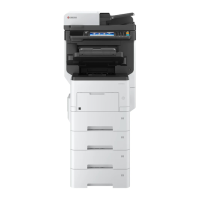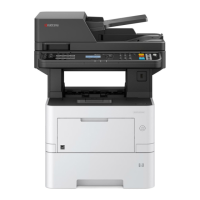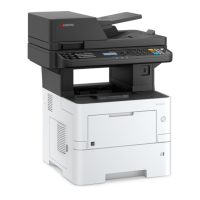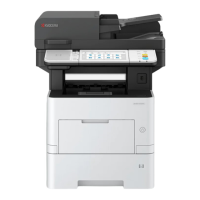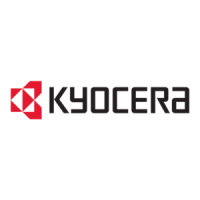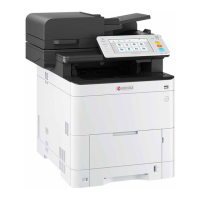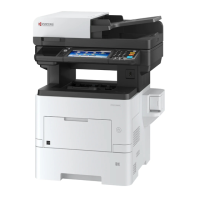
Do you have a question about the Kyocera ECOSYS M3860idn and is the answer not in the manual?
| N-up printing | 2, 4, 6, 8, 9, 16, 25 |
|---|---|
| Barcode printing | Yes |
| Print technology | Laser |
| Maximum resolution | 1200 x 1200 DPI |
| Duplex printing mode | Auto |
| Print margin top (min) | 4 mm |
| Time to first page (black, normal) | 4.5 s |
| Print speed (black, normal quality, A4/US Letter) | 60 ppm |
| Duplex print speed (black, normal quality, A4/US Letter) | 43 ppm |
| Copier resize | 25 - 400 % |
| Maximum copy resolution | 600 x 600 DPI |
| Maximum number of copies | 999 copies |
| N-in-1 copy function (N=) | 2, 4 |
| Time to first copy (black, normal) | 6 s |
| Copy speed (black, normal quality, A4) | 60 cpm |
| Scan to | E-mail, FTP, SMB, TWAIN, USB, WIA |
| Scan drivers | TWAIN, WIA |
| Scanner type | Flatbed & ADF scanner |
| Grayscale levels | 256 |
| Maximum scan area | 216 x 915 mm |
| Scan speed (color) | 40 ppm |
| Image formats supported | JPEG, MMR, TIFF |
| Duplex scan speed (black) | 120 ppm |
| Duplex scan speed (color) | 80 ppm |
| Document formats supported | PDF, XPS |
| Optical scanning resolution (black) | 600 x 600 ppi |
| Faxing | Mono faxing |
| Fax memory | 200 pages |
| Modem speed | 33.6 Kbit/s |
| Fax coding methods | JBIG, MH, MMR (Fax coding method), MR |
| Fax resolution (black) | 400 x 400 DPI |
| Fax transmission speed | 3 sec/page |
| Ink tank system | No |
| Printing colors | Black |
| Duplex functions | Copy, Fax, Print, Scan |
| Maximum duty cycle | 300000 pages per month |
| Recommended duty cycle | 5000 - 20000 pages per month |
| Replacement cartridges | TK-3160 (toner, 12.500 afdrukken 5% dekking) TK-3170 (toner, 15.500 afdrukken 5% dekking) TK-3190 (toner, 25.000 afdrukken 5% dekking) TK-3200 (toner, 40.000 afdrukken 5% dekking) |
| Number of print cartridges | 1 |
| Page description languages | Epson LQ, IBM ProPrinter XL24E, OpenXPS, PCL 5c, PCL 6, PCL XL, PDF 1.7, TIFF |
| Display | TFT |
| Control type | Touch |
| Product color | Black, White |
| Display diagonal | 7 \ |
| Market positioning | Business |
| AC input voltage | 220 - 240 V |
| AC input frequency | 50 - 60 Hz |
| Power consumption (max) | 1276 W |
| Power consumption (off) | 0.09 W |
| Power consumption (ready) | 24 W |
| Power consumption (sleep) | 0.5 W |
| Power consumption (copying) | 798 W |
| Power consumption (printing) | 723 W |
| Power consumption (average operating) | 773 W |
| Energy Star Typical Electricity Consumption (TEC) | 3 kWh/week |
| Processor cores | 2 |
| Processor family | ARM Cortex-A9 |
| Coprocessor frequency | 0.1 GHz |
| Card reader integrated | - |
| Compatible memory cards | SD, SDHC |
| Maximum internal memory | 3072 MB |
| Sound power level (standby) | 23.5 dB |
| Sound pressure level (printing) | 55.5 dB |
| Certification | TÜV/GS, CE |
| Optional connectivity | Ethernet, Wireless LAN |
| USB 2.0 ports quantity | USB 2.0 ports have a data transmission speed of 480 Mbps, and are backwards compatible with USB 1.1 ports. You can connect all kinds of peripheral devices to them. |
| Email protocols | POP3, SMTP |
| Cabling technology | 10/100/1000Base-T(X) |
| Security algorithms | IPSec, SNMPv3 |
| Ethernet LAN data rates | 10, 100, 1000 Mbit/s |
| Mobile printing technologies | Apple AirPrint, Google Cloud Print, Kyocera Mobile Print, Mopria Print Service |
| Paper input type | Cassette |
| Maximum input capacity | 2600 sheets |
| Maximum number of input trays | 6 |
| Multi-Purpose tray input capacity | 100 sheets |
| Mac operating systems supported | Mac OS X 10.10 Yosemite, Mac OS X 10.11 El Capitan, Mac OS X 10.12 Sierra, Mac OS X 10.13 High Sierra, Mac OS X 10.14 Mojave, Mac OS X 10.15 Catalina, Mac OS X 10.9 Mavericks |
| Scan media weight | 50 - 120 g/m² |
| Custom media width | 105 - 216 mm |
| Maximum print size | 216 x 356 mm |
| Custom media length | 148 - 356 mm |
| Paper tray media types | Plain paper |
| Paper tray media weight | 60 - 120 g/m² |
| Non-ISO print media sizes | Folio (media size), Legal (media size), Letter (media size) |
| ISO A-series sizes (A0...A9) | A4, A5, A6 |
| ISO B-series sizes (B0...B9) | B5, B6 |
| Multi-purpose tray media types | Envelopes, Legal, Letter, Plain paper, Recycled paper, Thick paper, Thin paper |
| Maximum ISO A-series paper size | A4 |
| Multi-Purpose Tray media weight | 60 - 220 g/m² |
| Operating altitude | 0 - 3500 m |
| Non-operating altitude | 0.6 - 15000 m |
| Storage temperature (T-T) | -20 - 40 °C |
| Operating temperature (T-T) | 10 - 32.5 °C |
| Storage relative humidity (H-H) | 10 - 90 % |
| Operating relative humidity (H-H) | 15 - 80 % |
| Sustainability certificates | Blue Angel, RoHS, EPEAT Silver, ENERGY STAR |
| Cables included | AC |
| Included cartridge capacity (black) | 11000 pages |
| Package depth | 570 mm |
| Package width | 633 mm |
| Package height | 730 mm |
| Package weight | 32000 g |
| Harmonized System (HS) code | 84433100 |
| Depth | 495 mm |
|---|---|
| Width | 480 mm |
| Height | 613 mm |
Specifies the supported models for this operation guide.
Instructions on locating and verifying the equipment's serial number.
Details safety warnings, symbols, and general precautions for safe machine operation.
Covers safety precautions for consumables and environmental conditions for operation.
Provides laser safety information for Europe and USA, including safety classifications.
Highlights security risks and precautions when using wireless LAN connections.
Details trade names, software licenses, and compliance with regulations like FCC.
Identifies external components and parts of the machine exterior.
Explains how to connect the machine to PCs or other devices using various cables.
Detailed steps for turning the machine's power on and off safely.
Guide to navigating and using the machine's control panel and touch screen interface.
Instructions for logging in and out of the machine for user authentication.
Steps for configuring wired and wireless network connections for the machine.
Procedure for installing necessary software on a PC from the included DVD.
How to access and use Command Center RX for machine settings and management.
Explains the standard method for printing from a PC using the KX DRIVER.
Guidance on registering and printing custom paper sizes not in standard lists.
Steps for configuring the printer driver for banner printing jobs.
Details the various tabs and options available in the printer driver settings.
Procedure to cancel a print job that has been sent from a computer.
Instructions for printing documents stored in Job Boxes like Private Print and Stored Job.
How to access, exit, and interpret the information displayed by the Status Monitor.
Guidance on placing originals on the platen and in the document processor.
How to register, recall, and manage frequently used functions as favorites.
Steps for installing, activating, and uninstalling machine applications.
Procedure for creating and managing shortcuts for frequently used functions.
Step-by-step guide for performing basic copying functions.
Overview of sending scanned images via E-mail, Folder, or WIA/TWAIN.
Explanation of Document Box types and procedures for managing Custom Boxes.
Instructions for printing files stored on a USB drive directly from the machine.
Procedure for scanning documents and saving them to a USB drive.
Details on Paper Selection, Zoom, Density, Duplex, Combine, Quiet Mode, etc. for copying.
Options for Color Selection, Quiet Mode, File Format, Original Size, Duplex, etc. for sending.
Settings for Duplex, Scan Resolution, Density, File Name Entry, Color Selection, etc. for Custom Box.
Settings for File Format, Duplex, Scan Resolution, Density, File Name Entry, Color Selection, etc. for USB Drive.
Adjusting Sharpness, Contrast, Background Density, and Prevent Bleed-through for image quality.
Adjusting zoom levels and layout for sending/storing images.
Setting passwords and restrictions for PDF files to enhance security.
Configuration for Optical Character Recognition to create searchable files.
Settings for dividing scanned data into files and adjusting scan resolution.
How to view the status of print, send, store, and scheduled jobs.
Procedures for viewing completed job histories and sending log information.
Instructions for pausing, resuming, or canceling active jobs.
Checking status of connected devices like Scanner, Printer, USB Drive, and Network.
Monitoring the remaining amounts of toner, paper, and staples on the machine.
How to access and navigate the System Menu for machine configuration.
Adjusting common settings like Default Screen, Sound, Original Settings, and Paper Settings.
Setting default values for various functions like File Format, Orientation, Scan Resolution.
Configuring responses to errors and units for paper dimensions.
Configuring Host Name, Wi-Fi Direct, Wi-Fi, TCP/IP, and other network settings.
Managing data security, overwriting, and system initialization for data protection.
Explains how user access is administered and the different security levels.
Steps to enable user login administration and select authentication methods.
Configuring authentication security, lockout settings, and password policies.
How to add new users, change properties, and delete users from the local list.
Managing users for PC printing, TWAIN scanning, WIA scanning, and PC faxing.
Setting restrictions for machine usage based on local users, groups, or guest access.
Configuring simple login and ID card authentication methods for easier access.
Understanding and setting up job accounting for managing print, scan, and fax usage.
How to count printed pages and generate accounting reports for usage tracking.
Routine cleaning procedures for glass, slit glass, and registration roller.
Instructions for replacing the toner container and waste toner box when empty.
Guidelines for troubleshooting common symptoms like application errors, screen response issues.
Guidance on how to respond to various error and informational messages displayed.
Step-by-step instructions for removing paper jams from different machine locations.
Procedure for clearing staple jams from the manual stapler unit.
Lists and illustrates available optional hardware and software for the machine.
Instructions on using the on-screen keyboard for entering text and names.
Details on supported paper types, sizes, weights, and handling precautions.
Technical specifications for the machine's hardware, including dimensions and memory.
Details on printer functions like printing speed, resolution, and supported emulations.
Specifications for scanner resolution, file formats, and document processor capabilities.
Definitions of technical terms and features used throughout the manual.
